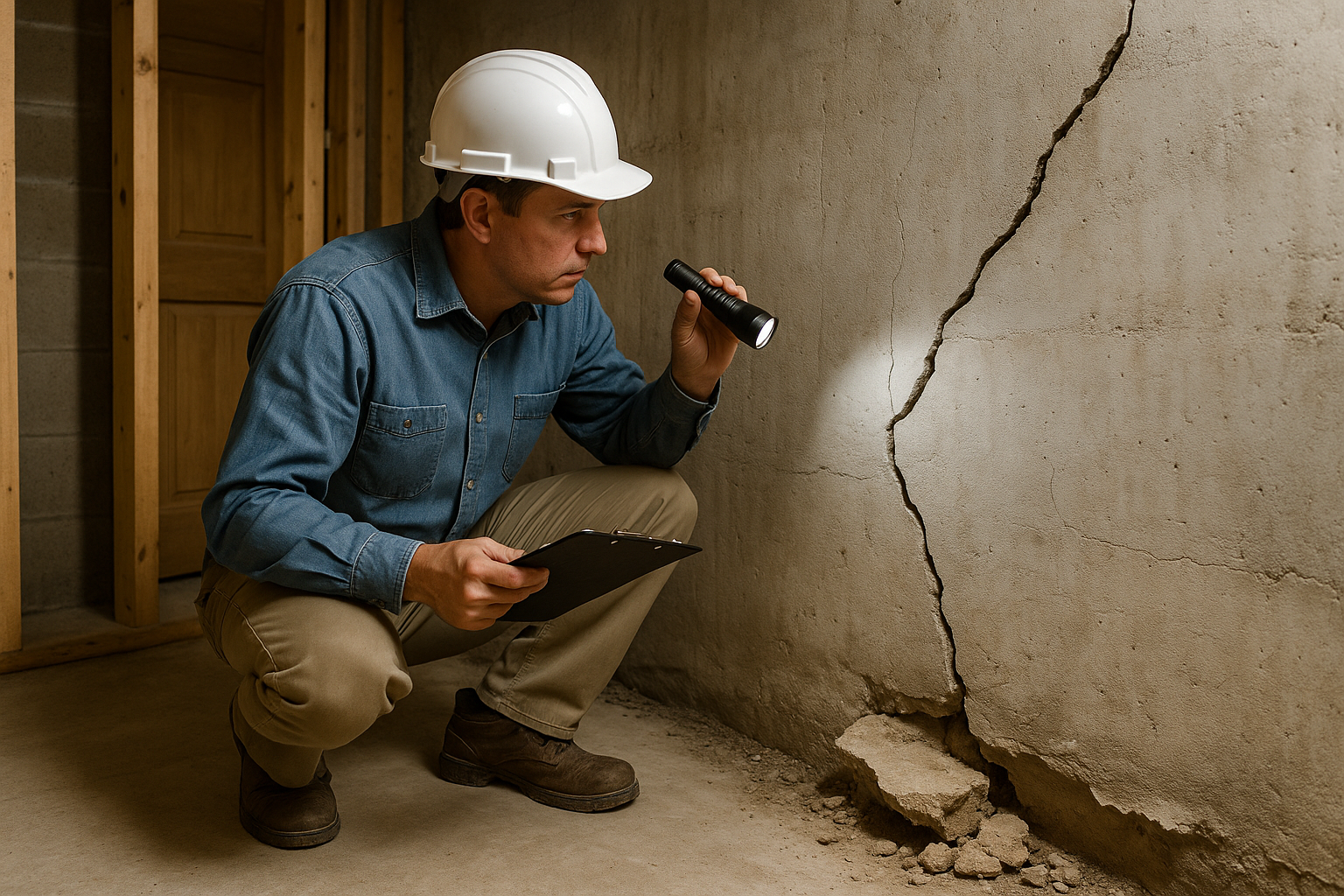Foundation Problems Show Up Fast
Cracks, sloping floors, and doors that won’t close right mean the foundation is moving. In Flagstaff, shifting soil and freeze-thaw cycles make these problems show up early. You’ll see diagonal cracks wider than a pencil, bowing walls, and concrete breaking off. These are signs the ground under your house isn’t stable. When this happens, you need structural inspection professionals who know what to look for under the surface.

- Diagonal cracks wider than 1/4 inch in foundation walls
- Floors that tilt or feel uneven underfoot
- Doors and windows that stick or won’t close
- Gaps where walls meet ceilings or floors
- Foundation walls that bow or lean
- Concrete that crumbles or flakes away
These aren’t just cosmetic issues. They point to deeper trouble. Soil shifts. Water seeps in. The structure starts to move. Only certified home inspection professionals with real experience in Flagstaff’s conditions can spot the difference between a harmless crack and a sign of major failure.
Drainage and Grading Make or Break a Foundation
Water never takes a day off. It finds every low spot, every crack, every weak point. In Flagstaff, snowmelt and summer storms dump water fast. If the ground slopes toward your house, water pools against the foundation. Gutters overflow. Downspouts dump water right at the base. Over time, water works its way in. Concrete softens. Wood rots. Mold grows. The freeze-thaw cycle widens every gap. During thorough exterior inspections, we walk the perimeter. We look for standing water, soggy soil, and places where the ground should drop away from the house but doesn’t. A six-inch drop over ten feet keeps water moving away. Anything less, and trouble starts.
- Gutters clogged or missing extensions
- Downspouts dumping water at the foundation
- Soil sloping toward the house
- Standing water after rain or snowmelt
- Basement or crawl space dampness
Water intrusion doesn’t just stain walls. It weakens the structure. Over time, it eats away at interior structural elements. Mold and rot set in. The only way to stop it is to spot the drainage problems early and fix them before the damage spreads.
Support Systems Show the Real Story
Every house stands on its bones. Load-bearing walls, beams, and posts carry the weight. When these supports fail, the whole structure suffers. In crawl spaces, moisture collects. Wood swells, then shrinks. Metal rusts. Beams sag. Posts tilt. Sometimes, a previous owner cuts a beam or moves a post to make room for plumbing or ductwork. That shortcut leaves the house vulnerable. During inspections, our team checks every support. We look for missing posts, notched beams, and signs of stress: cracks, splits, or shifting. Crawl space conditions often reveal the first signs of trouble. Mold on joists. Water stains. Insect damage. These details tell the real story of a home’s stability.
- Beams with cracks or notches
- Posts that lean or sit on soft soil
- Joists with water stains or mold
- Unusual gaps between framing members
- Signs of past repairs or makeshift fixes
Support systems don’t lie. They show every shortcut, every missed repair, every hidden problem. A thorough inspection finds these issues before they turn into expensive repairs.
Long-Term Stability Starts with the Ground
Flagstaff’s soil doesn’t play by the rules. Some lots sit on clay that swells and shrinks. Others rest on rocky fill that shifts with every freeze. A house built on the wrong foundation type for its soil starts to move. Cracks widen. Floors settle. Doors go out of square. We look at more than just today’s problems. We check for signs that the ground is moving. We review drainage patterns, soil type, and the way the foundation was built. Our reports don’t just list what’s wrong now. They point out what could go wrong next year or five years from now. That’s how you avoid surprises.
- Soil pulling away from the foundation
- Repeated repairs in the same area
- Patterns of cracking that match soil movement
- Drainage that changes with the seasons
Long-term stability isn’t luck. It’s the result of careful design, good drainage, and regular checks by people who know what to look for. A quick walk-through misses the warning signs. A real inspection digs deeper.
What to Expect from a Real Inspection
Every inspection should leave you with answers, not more questions. You get a clear list of what’s solid and what needs work. No uncertainty. No vague warnings. Just facts. At Aspen Home Inspections, we check every inch of the foundation, every support, every drainage path. We look for the problems that matter: cracks, movement, water, and shortcuts in construction. We don’t just point out issues. We explain what they mean for your home’s future. That’s the difference between a quick look and a real inspection.
- Detailed photos of every concern
- Clear explanations in plain language
- Action steps for repairs or further evaluation
- Advice specific to Flagstaff’s unique conditions
When you know what’s happening under your house, you can make smart decisions. You avoid costly surprises. You protect your investment.
Schedule Your Foundation Inspection Today
Call Aspen Home Inspections at 928-600-7761 or contact us for a thorough evaluation of your home's structural integrity.


